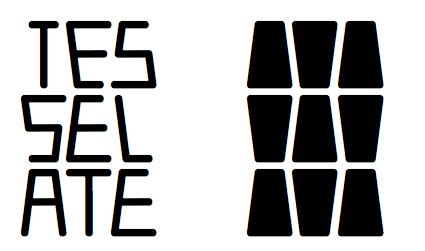It has been more than nine months since I posted here. During that time I have been designing typefaces, investigating what is possible using the OpenType feature Contextual Alternatives (calt). There are few typefaces that use this feature to alternate two character sets, perhaps because the results appeal to a niche market and serious type designers have better uses of their time than to design for a minuscule market. I like the feature because it gives interesting results when there is a geometrical connection between the two character sets that are alternated. My first use of the feature was to alternate letter sets that were based on trapezoids.
Notice that the trapezoids that serve as templates on which the letters are formed will tessellate. Tessellations were not on my mind when I designed this face. I was focused only on how the letters fit together in a word. However. I realized later that the template shape was part of a tessellation pattern, in the IH58 type. It can be constructed in several ways. The tops and bottoms can rotate 180º or flip to form neighbors. The sides can be C edges that rotate around their centers to form neighbors, or they can be considered glide edges. In terms of symbols, it could be CCCC, CGCG, CFCF, or GFGF.
The typeface above did not exhaust the possibilities of trapezoidal letters, so I did a second family with a similar template but with letters that look very different.
Another trapezoidal shape that tessellates is formed by bisecting a regular hexagon. In this case I put the straight sides between letters and the interlocking part of the pattern on the top and bottom.The trapezoid can be asymmetrical, as in the example below where the trapezoid was formed by cutting a rectangle into two equal parts with a slanted line. The pattern here can be formed by flipping the shape over the top and bottom and rotating it around the center of its sides. It fits the Grünbaum-Shepard IH49 classification.
I followed up with letters formed with templates of rectangles and parallelograms that give a wave to a line of text. I did not think of tessellations when designing these, but the first template shape tessellates as a TCTC pattern (and also TGTG, CGCG, and G1G2G1G2) and belongs to the IH-66 class. In the second pattern, the tops and bottoms can be either center-point-rotation or translated edges and the sides can be either glided or flipped edges.
Using alternating characters one can design text that has a wave both horizontally and vertically. The template of the first of these is a IH-73 pattern (C4C4C4C4 at all corners, though it can also be formed as G1G1G2G2) and the second as an IH-71 pattern (fits both C4C4C4C4 and G1G2G1G2). The template shape in the second sample will tessellate in one orientation, two orientations, or four orientations. Only the four-orientation pattern is shown below.
Both of these typefaces are based on a template of distorted squares.
I suspect a reason that I am willing to pursue this line of inquiry is because I like tessellations more than other type designers. No one else that I know of has designed multiple fonts from shapes that can form tessellation patterns.
For more information about these and other typefaces with alternating characters, see my type blog at nohyptype.blogspot.com
































